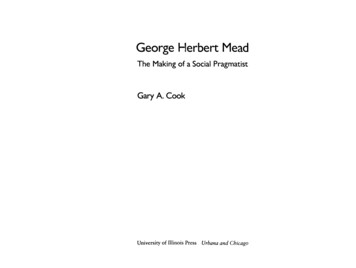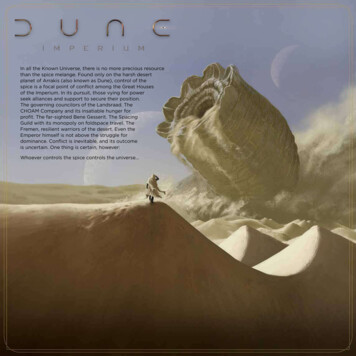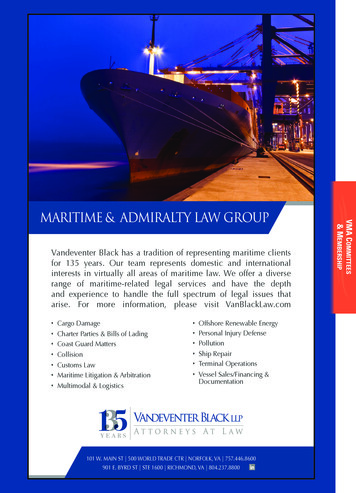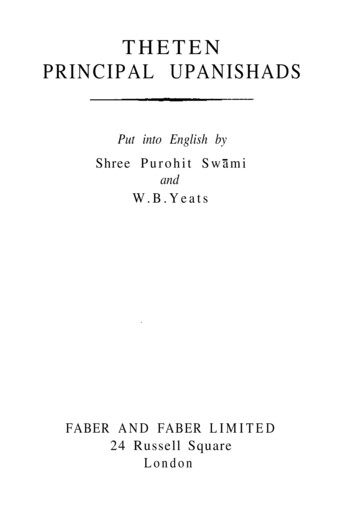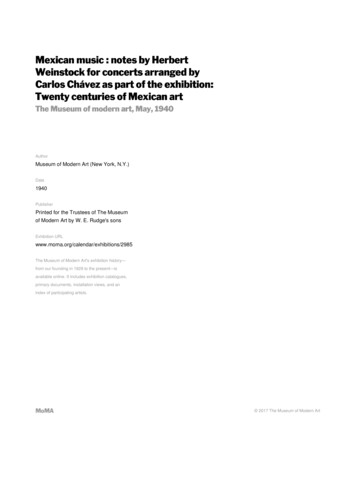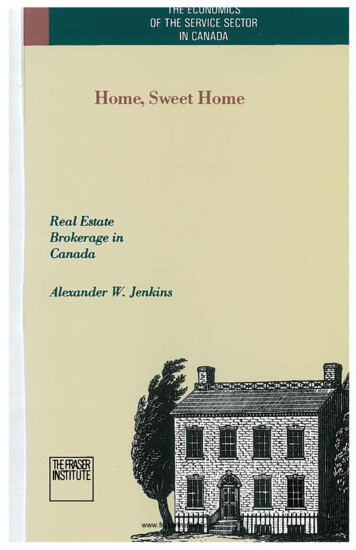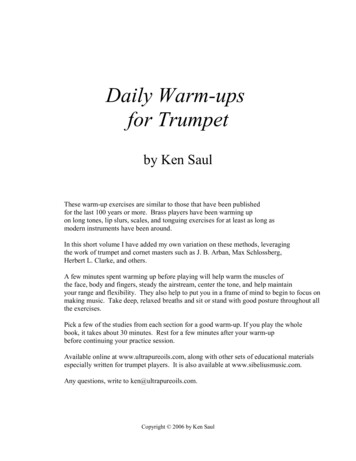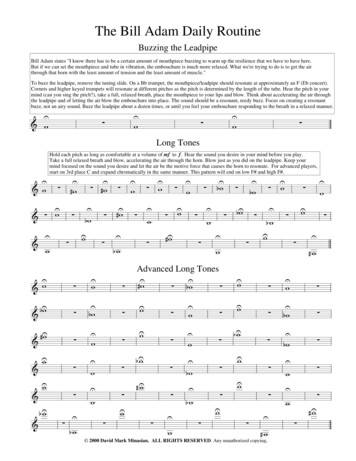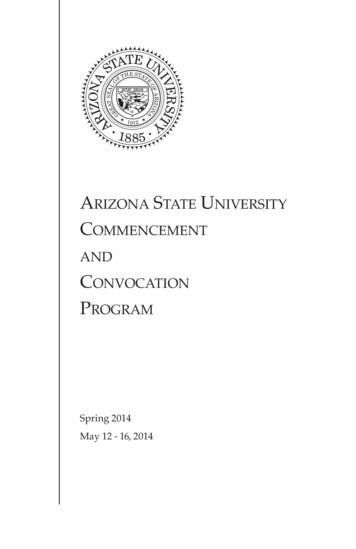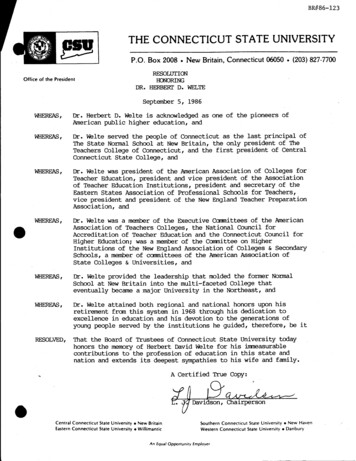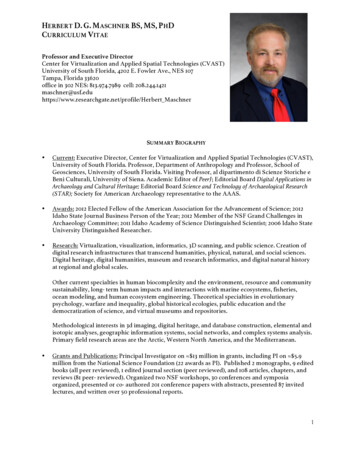
Transcription
HERBERT D. G. MASCHNER BS, MS, PHDCURRICULUM VITAEProfessor and Executive DirectorCenter for Virtualization and Applied Spatial Technologies (CVAST)University of South Florida, 4202 E. Fowler Ave., NES 107Tampa, Florida 33620office in 302 NES: 813.974.7989 cell: te.net/profile/Herbert MaschnerSUMMARY BIOGRAPHY Current: Executive Director, Center for Virtualization and Applied Spatial Technologies (CVAST),University of South Florida. Professor, Department of Anthropology and Professor, School ofGeosciences, University of South Florida. Visiting Professor, al dipartimento di Scienze Storiche eBeni Culturali, University of Siena. Academic Editor of PeerJ; Editorial Board Digital Applications inArchaeology and Cultural Heritage; Editorial Board Science and Technology of Archaeological Research(STAR); Society for American Archaeology representative to the AAAS. Awards: 2012 Elected Fellow of the American Association for the Advancement of Science; 2012Idaho State Journal Business Person of the Year; 2012 Member of the NSF Grand Challenges inArchaeology Committee; 2011 Idaho Academy of Science Distinguished Scientist; 2006 Idaho StateUniversity Distinguished Researcher. Research: Virtualization, visualization, informatics, 3D scanning, and public science. Creation ofdigital research infrastructures that transcend humanities, physical, natural, and social sciences.Digital heritage, digital humanities, museum and research informatics, and digital natural historyat regional and global scales.Other current specialties in human biocomplexity and the environment, resource and communitysustainability, long- ‐ term human impacts and interactions with marine ecosystems, fisheries,ocean modeling, and human ecosystem engineering. Theoretical specialties in evolutionarypsychology, warfare and inequality, global historical ecologies, public education and thedemocratization of science, and virtual museums and repositories.Methodological interests in 3d imaging, digital heritage, and database construction, elemental andisotopic analyses, geographic information systems, social networks, and complex systems analysis.Primary field research areas are the Arctic, Western North America, and the Mediterranean. Grants and Publications: Principal Investigator on 13 million in grants, including PI on 5.9million from the National Science Foundation (22 awards as PI). Published 2 monographs, 9 editedbooks (all peer reviewed), 1 edited journal section (peer reviewed), and 108 articles, chapters, andreviews (81 peer- ‐ reviewed). Organized two NSF workshops, 30 conferences and symposiaorganized, presented or co- ‐ authored 201 conference papers with abstracts, presented 87 invitedlectures, and written over 50 professional reports.1
ADMINISTRATIVE APPOINTMENTS2015-present2010-20152009-20152007- ‐ 20132007-20102007- ‐ 2008Executive Director, Center for Virtualization and Applied Spatial Technologies,University of South Florida.Director, Idaho Museum of Natural History.Research Curator, Division Head of Anthropology, Idaho Museum of Natural History.Founding Director, Center for Archaeology, Materials, and Applied Spectroscopy(CAMAS).Director of Graduate Studies, Department of Anthropology, Idaho State University.Chair, Department of Anthropology, Idaho State UniversityACADEMIC APPOINTMENTS2015-presentProfessor (tenured), Department of Anthropology and the School of Geosciences,University of South Florida.2015Visiting Professor, al dipartimento di Scienze Storiche e Beni Culturali, University ofSiena.2007- ‐ 2015Anthropology Research Professor (tenured), Department of Anthropology, Idaho StateUniversity. Report to the VP of Research and Economic Development.2007-2015Senior Scientist and Affiliate Professor, Idaho Accelerator Center.2006-2007Professor (tenured), Department of Anthropology, Idaho State University.1999-2006Associate Professor, Department of Anthropology, Idaho State University.2002-2008Consulting Scientist, Aleut Marine Mammal Commission.1998-1999Affiliate Scientist, University of Alaska Museum, Alaska Quaternary Center,University of Alaska, Fairbanks.1993-1999Assistant Professor, Department of Anthropology, University of Wisconsin-Madison;Faculty, Russian, Central Asian and East European Studies Program; Affiliate Faculty,Institute for Environmental Studies.1992-1993Visiting Scholar, Center for Archaeological Investigations, Southern IllinoisUniversity, Carbondale.1992-Summer Lecturer, Department of Anthropology, University of California, Santa Barbara.1989-1992Social Sciences Coordinator for Geographic Information Systems and Statistics, SocialScience Computing Facility, University of California, Santa Barbara.1987-1989Teaching Assistant, Department of Anthropology, UCSB.1983-1985Teaching Assistant, Department of Anthropology, University of Alaska, Fairbanks.EDITORIAL AND PROFESSIONAL -2008Editorial Board Science and Technology in Archaeological Research.Editorial Board Digital Applications in Archaeology and Cultural Heritage.Academic Editor of PeerJ.Anthropology and Archaeology Section Chair, Pacific Division, American Associationfor the Advancement of Science.Society for American Archaeology Representative to the American Association for theAdvancement of Science.Associate Editor, Journal of World Prehistory.Editorial Board, Alaska Journal of Anthropology.Executive Director, Foundation for Anthropological Research and EnvironmentalStudies (FARES).Series co-Editor, Anthropology of Pacific North America. University of Utah Press.2
EDUCATION1987-92. Ph.D. in Anthropology (Archaeology specialization), Department of Anthropology, Universityof California, Santa Barbara. Dissertation title: The Origins of Hunter-Gatherer Sedentism andPolitical Complexity: A Case Study from the Northern Northwest Coast. Dissertation Advisors:Michael Jochim, Brian Fagan, Mark Aldenderfer, and Napoleon Chagnon.1989-90. ESRI - ARC/INFO Geographic Information Systems Training1983-87. MS in Archaeology, Department of Anthropology, University of Alaska, Fairbanks. Thesistitle: Site Structure, Site Use, and Site Reuse of an Ahtna (Na Dene) Spring Camp. Thesis Advisors:William Roger Powers, Anne Shinkwin, David M. Hopkins1984. Norwich University Russian School, Vermont, Summer.1980-83. University of New Mexico, Albuquerque, BS Anthropology. Undergraduate Advisors /mentors: Lewis R. Binford, Jeremy Sabloff, Henry Harpending, Pat Draper.1978. 1979-80 University of Wyoming, Laramie, Wyoming.1977. West Valley High School, Fairbanks, Alaska.MAJOR AWARDS, HONORS AND KEYNOTE PRESENTATIONSOpening Address, Chancen und Möglichkeiten von 3D-Digitalisiung für Forschung und Gesellschaft.Museum für Naturkunde, Berlin, 2014.Keynote Address, ARQUEOLÓGICA 2.0, the 6th International Meeting on Graphic Archaeology andInformatics, Cultural Heritage and Innovation, Spanish Digital Heritage, Ciudad Real, Spain,2014.Invited Workshop, ICAZ, San Rafael, Argentina, 2014Keynote Address, Digital Specimen Conference, Museum für Naturkunde, Berlin, 2014Panelist, Smithsonian X3D Conference, Washington DC, 2014Elected Fellow of the American Association for the Advancement of Science, 2012.Idaho State Journal Business Person of the Year 2012 -- EducationMember of the NSF Grand Challenges in Archaeology Committee, Santa Fe Institute, Santa Fe,August 2012.Idaho Academy of Science Distinguished Scientist 2011 (solo award).ISU Distinguished Researcher 2006 (solo award).ISU Outstanding Researcher 2006 (one of five).ISU Outstanding Researcher 2005 (one of four).Keynote address: Annual meeting of the Aleut Corporation, 2005.ISU Most Influential Professor 2005. For Amber Tews’ Outstanding Master’s Student Award.Keynote Speaker, Science Day. International Arctic Summit, Kunming, China 2005.Keynote Speaker, Arctic Section AAAS, Fairbanks, Alaska 2003.Society for American Archaeology “Best Student Poster” (Laura Smith et al.) 2002.Keynote Speaker, SILA Lectures, National Museum of Denmark, Copenhagen November, 2001.Keynote Address: Annual meeting of the Aleut Corporation, 1995RESEARCH SUMMARYAreas of ResearchVirtual museums, virtual repositories, web-databases, public presentation of heritage including digitalhumanities, multi-media education and research, and the democratization of science.Laser and light scanning technologies, 3D visualization software, remote sensing, information systems,and digital analytics.Biocomplexity, human-engineered ecosystems, landscape dynamics, resource sustainability, humansas members of marine and terrestrial ecosystems.Instrumentation, photon activation, elemental and isotopic analysis, remote sensing, geographicinformation systems, and spatial analysis in human behavior studies.Human - landscape interactions and behavioral responses to catastrophic environmental change.Anthropological theory, Darwinian theory, evolutionary ecology, complex systems.3
The archaeology, politics, organization, and structure of village-based societies and the rise ofsedentary and ranked communities.The evolution, archaeology and anthropology of warfare.Peoples of the north; sustainability; applied and community-based archaeology; prehistory, ecology,ethnography and ethnohistory of Alaska, the North American Arctic, Greenland, theNorthwest Coast, western North America, and Siberia.Major Research Projects as Principle InvestigatorVirtual Repositories and the Democratization of Science 2012-2022.Virtual Repository of Arctic Archaeology 2013-1016.Virtual Museum of Idaho Project 2011-2015.Hot Springs Archaeological Project 2013-2016Virtual Zooarchaeology of the Arctic Project (VZAP) 2008-2014.North Aleutian Basin Subsistence Study (co-PI) 2008-2012.Sanak Biocomplexity Project 2006-2013.Sanak Island Complex Human-Ecological Systems Project 2004-2006.Steller Sea Lion TEK and Aleut historical ecology/geography Project. Alaska Peninsula 2003-2006.Hot Springs Site Documentation, Archival, and Publication Project 2002-2005.Bering Sea Biocomplexity Project. 2001-2004.Lower Alaska Peninsula and Eastern Aleutian Islands Catastrophic Change Project. 1994-2004.Warfare and Landscape in the North Project (with K. Reedy-Maschner). 1997-2002.Northwest Coast Hunter-Gatherer Complexity, Kuiu Island, Southeast Alaska. 1988-1994.Forager Site Structure, Tazlina Lake, Copper River Valley, Alaska. 1985-1987.Fieldwork in Honduras, France, Morocco, Spain, Guatemala, the American Southwest, California, theHigh Plains, and throughout Alaska and the Northwest Coast. Ethnographic fieldwork inSoutheast Alaska (Tlingit) and the eastern Aleutian Islands/western Alaska Peninsula(Unangan).MAJOR GRANTSSUMMARY: Grants from NSF, NASA, NOAA, USFWS, USDA Forest Service, Wenner-GrenFoundation, and local agencies. PI 13 million in grants, which includes PI on 5.9 million fromthe National Science Foundation.2015 Hitz Foundation for Virtualization Center2013 Murdock Trust – Virtual Museum of Idaho, PI2013 The Monsanto Fund, PI2013 The Anne Staton Voilleque Charitable Foundation, PI2013 The William J & Shirley A Maeck Family Foundation, PI2013 NSF EAGER. Virtual Museum of the Arctic Pilot Project, PI.2013 NSF OPP Collaborative Research. The Hot Springs Village Site: a Window toSouthern Bering Sea Paleo-Ecosystems and Human - LandscapeInteractions, PI.2013 Hitz Foundation: Helicoprion Shark exhibit, PI2012 Albertson’s Foundation: IMNH Science Discovery Center, PI.2012 Hitz Foundation Award: Virtual Museum of Idaho, PI.2012 NSF OPP RAPID: Cataloging and Returning to Alaska the NSF fundedTebenkof Bay Project, PI.2012 NSF RAPID: 3D Scanning and Virtualization of a Juvenile Orca at the SitkaScience Center, PI.2011 NSF OPP: Virtual Repositories for a Global Archaeological ScienceWorkshop, PI.2011 Hitz Foundation Award- Museums, PI 4,682,180 266,000 17,500 25,000 25,000 297,000 340,646 25,000 50,000 650,000 23,803 13,250 25,001 50,0004
2010 NSF OPP Virtual Zooarchaeology of the Arctic Project: Phase 2, PI 1,029,2322010 SBOE: Virtual Museum of Idaho Project, Tech. Incentive Grant. Co-PI 135,0002010 Akutan Geothermal Project. PI 40,0002010 Hitz Foundation Award, PI. 60,0002009 Supplement to: NSF OPP Complex Ecosystem Interactions over Multiple 219,850Spatial and Temporal Scales: the Biocomplexity of Sanak Island. PI2009 Supplement to: NSF OPP Complex Ecosystem Interactions over Multiple 9,550Spatial and Temporal Scales: the Biocomplexity of Sanak Island. PI2009 Akutan Rural Power Systems Project. City of Akutan, Alaska 35,0002008 MMS North Aleutian Basin Subsistence Study. Co- ‐ PI 339,0002008 NSF OPP Virtual Zooarchaeology of the Arctic Project. PI 310,6052008 NSF MRI Purchase of an ESEM. PI 372,2302008 BIA ANCSA Aleutian GIS Project. PI 50,0002008 BIA Alaska Excavations on the Sapsuk River, Alaska. PI 97,0002007 Idaho National Laboratory Collaboration Grant 8,7002007 NSF MRI: Acquisition of Mass Spectrometers and Related Equipment to 587,410Create the ISU Interdisciplinary Lab for Elemental and IsotopicAnalysis (ILEIA). PI2005 NSF OPP Complex Ecosystem Interactions over Multiple Spatial and 1,150,000Temporal Scales: the Biocomplexity of Sanak Island. PI2005 NSF OPP Supplement to National Science Foundation, Polar Programs, 32,225Investigating Complex Human-Ecological Systems OverMultidimensional Temporal, Spatial, and Demographic Scales: theSanak Island Project. PI2004 USFWS Subsistence: Western Alaska Peninsula and Aleutian Traditional 63,519Subsistence Fisheries Evaluation and Traditional EcologicalKnowledge Project. co-PI.2004 NSF OPP, REU Supplement for the Sanak Islands Project. 15,6412004 NSF OPP, Investigating Complex Human-Ecological Systems Over 340,000Multidimensional Temporal, Spatial, and Demographic Scales: theSanak Island Project. PI2003 Aleutians East Borough, King Cove Access Survey, Cold Bay, Alaska. PI 26,5962003 NSF OPP, Heritage Supplement for Research on the Lower Alaska Peninsula. 49,433PI2002 NSF OPP, Logistics Supplement for Research on the Lower Alaska Peninsula. 27,350PI2002 NOAA: Indigenous Observations, Traditional Ecological Knowledge, and 393,450Spatio-temporal Dynamics of Steller Sea Lion Populations along theWestern Alaska Peninsula and Eastern Aleutians. PI2002 USFWS Subsistence: Western Alaska Peninsula and Aleutian Traditional 141,891Subsistence Fisheries Evaluation and Traditional EcologicalKnowledge Project. co-PI2001 NSF OPP SGER: Proposal to Analyze, Catalogue, and Return to Alaska 29,950Materials from the Hot Springs Village Site Currently in Sapporo,Japan. PI2001 NSF BE/CNH: Agent-Based Modeling of Bering Sea Biocomplexity: Long-term 80,000Ecological Effects of Human-Salmon Interactions. PI2001 NSF OPP, Supplement to conduct a Heritage Field School in the village of 18,672King Cove, Alaska. PI2000 NASA Landscape and Vegetation Change Studies in the Upper Snake River 450,000Region. co-PI.1999 NSF OPP, Catastrophic Landscape Change and the Evolution of North Pacific 543,500Societies (for 1999-2003). PI1998 University of Wisconsin Graduate School Grant: Catastrophic Landscape 9,000Change and Human Adaptation on the Lower Alaska Peninsula. PI5
1998 Aleutians East Borough: Creating an Aleut Heritage Program. PI1997 NSF OPP, Research Exp. For Undergraduates: Subsistence and Palaeozoologyon the Lower Alaska Peninsula. PI1997 NSF OPP, Proposal to Create the Aleutian Research Consortium. PI1996 NSF OPP, Remote Sensing and Geographic Information System Developmentfor Archaeological, Ecological Geomorphological Reconnaissance onthe Lower Alaska Peninsula. PI1996 NSF OPP (w/ B. Hoffman-Dissertation), The Organization of Complexity: AStudy of Late Prehistoric Village Organization in the Eastern AleutianRegion. PI1994 UW Graduate School Research Grant: Settlement of the Lower AlaskaPeninsula and Unimak Island. PI1993 UW Graduate School Research Grant: Warfare and Rank on the NorthwestCoast. PI1993 USFS Cost-Share Grant for Fieldwork: Settlement of Saginaw Bay, KuiuIsland, Southeast Alaska. PI1991 NCGIA Conference Grant (with Aldenderfer): Geographic InformationSystems in Anthropology: An International Conference. PI1990 Wenner-Gren Predoctoral Grant: The Origins of Northwest CoastComplexity.1989 NSF (w/ Michael Jochim): The Origin and Maintenance of Ranked Society inTebenkof Bay, Southeast Alaska.1989 USFS Cost-Share Grant for Fieldwork: The Tebenkof Bay ArchaeologicalSurvey. 7,000 10,700 40,350 274,000 38,000 22,150 21,007 20,700 7,000 7,000 10,000 13,0006
PUBLICATIONSSummaryPublished, in press, or submitted (authored and co-authored): 2 monographs, 9 edited volumes, 1edited journal section, 108 articles, chapters, reviews (81 peer reviewed). Also, 30 conferencesand symposia organized, 201 conference presentations with abstracts, 87 invited lectures, and50 professional reports.Books and Edited Sections (all Peer Reviewed)12.2012. Katherine Reedy-Maschner and Herbert Maschner, editors. Sanak Island, Alaska: ANatural and Cultural History. Idaho Museum of Natural History, Pocatello.11.2010. Herbert Maschner, Buck Benson, Garrett Knudsen, Nicole Misarti. Archaeology of theSapsuk River, Alaska. Monographs of the Archaeology Branch, Alaska Region, Bureau of IndianAffairs.10.2009. Herbert Maschner, Owen Mason, Robert McGhee, editors. The Northern World AD 900- ‐1400. University of Utah Press, Salt Lake City.9.2008. Dimitra Papagianni, Robert H. Layton and Herbert Maschner. Time and Change:Archaeological and Anthropological Perspectives on the Long Term. Edited by Dimitra Papagianni,Robert H. Layton, and Herbert Maschner. Oxford: Oxbow Press.8.2007. R. Alexander Bentley, Herbert Maschner, and Christopher Chippindale, editors.Handbook of Archaeological Theories. Altamira Press.7.2005 Herbert Maschner and Christopher Chippindale, editors. Handbook of ArchaeologicalMethods. Altamira Press.6.2003 R. Alexander Bentley and Herbert D. G. Maschner, editors. Complex Systems andArchaeology: Empirical and Theoretical Applications. University of Utah Press, Salt Lake City.5.1999 Kenneth Ames and Herbert Maschner. Peoples of the Northwest Coast: Their Prehistory andArchaeology. London: Thames and Hudson.4.1996 Mark Aldenderfer and Herbert Maschner, editors. Anthropology, Space, and GeographicInformation Systems. Oxford University Press.3.1996 Herbert Maschner, editor. New Methods, Old Problems: Geographic Information Systems inModern Archaeological Research. Center for Archaeological Investigations Press, SouthernIllinois University.2.1996 Herbert Maschner, editor. Darwinian Archaeologies. Interdisciplinary Contributions toArchaeology Series, Plenum Press.1.1991 Herbert Maschner and Brian Fagan, editors. The Emergence of Cultural Complexity onthe West Coast of North America. Special Section Antiquity, 65:921-976.7
Articles, Chapters, and Reviews (Peer Reviewed **)In prep.Herbert Maschner and Owen Mason. An new integrated chronology for the origins of theAleut and Eskimo. Evolutionary Anthropology.111.**In review. Herbert D. G. Maschner. Village Aggregation, Complexity, and Productivity alongthe Greater North Pacific. Journal of World Prehistory.110.**In review. Roly Russell, Spencer A. Wood, Amber Tews, Dieta Lund, Herbert D.G.Maschner. The united insight of ancient midden archaeology and modern intertidal ecology:patterns of the intertidal ecosystem of Sanak Island, Western Gulf of Alaska over 4,500 years.109.**In review. Herbert Maschner, Amy Commendador and Amber Tews. New Dates on theWasden Site Question the Association between Folsom and Mammoth. American Antiquity.108.**In review. Jennifer A. Dunne, Matthew W. Betts, Nancy Huntly, Herbert Maschner, RolyRussell, Richard J. Williams, and Spencer Wood. The roles of human foragers in North Pacificmarine food webs. Biology Letters.107.**in press. Herbert Maschner1, Nicholas A. Holmer, Corey Schou, Buck Benson, Matthew Betts,Nicholas Clement, Jonathan Holmes, Jesse Pruitt, Robert Schlader. Creating a 3D DataPipeline for Scanning Large Archaeological Collections to Democratize ArchaeologicalAnalysis. Science and Technology in Archaeological Research.106.**2015. Herbert D. G. Maschner, The Archaeology of the Eastern Aleut Region. OxfordHandbook of Arctic Archaeology. Owen Mason and Max Frieson, editors. Oxford UniversityPress, Oxford.105.**2015. Herbert Maschner, Buck Benson, Nicholas Clement, Nicholas A. Holmer, Corey Schou.The Virtual Repository of Arctic Archaeology and the Democratization of Science.Proceedings of the Digital Heritage 2015 Conference, Granada.104.2015. Arctic archaeologies: recent work on Beringia. Antiquity. Vol. 89 No. 345 June 2015, pp 740742.103.**2015. N. Misarti and H. Maschner. The Paleo-Aleut to Neo-Aleut Transition Revisited. Journalof Anthropological Archaeology.102.**2014. K. Reedy-Maschner and Herbert Maschner. Traditional foods, corporate controls:Networks of household access to key marine species in southern Bering Sea villages. PolarRecord. 50 (255):364-378.101.**2014. Nicholas A. Holmer, Nicholas Clement, Kaitlyn Dehart, Herbert Maschner, JessePruitt, Robert Schlader, Myriam van Walsum. The Idaho Virtualization Laboratory 3DPipeline. Virtual Archaeology Review. Volumen 5 Número 10. ISSN: 1989-9947. Pp 21-31.100.**2014. Kintigh, Keith W., Jeffrey H. Altschul, Mary C. Beaudry, Robert D. Drennan, Ann P.Kinzig, Timothy A. Kohler, W. Fredrick Limp, Herbert D.G. Maschner, William K. Michener,Timothy R. Pauketat, Peter Peregrine, Jeremy A. Sabloff, Tony J. Wilkinson, Henry T. Wright,and Melinda A. Zeder. Opinion: Grand Challenges for Archaeology. Proceedings of the NationalAcademy of Science. January 21, 2014. Vol. 111, no. 3, 879-880.99.**2014. Kintigh, Keith W., Jeffrey H. Altschul, Mary C. Beaudry, Robert D. Drennan, Ann P.Kinzig, Timothy A. Kohler, W. Fredrick Limp, Herbert D.G. Maschner, William K. Michener,8
Timothy R. Pauketat, Peter Peregrine, Jeremy A. Sabloff, Tony J. Wilkinson, Henry T. Wright,and Melinda A. Zeder. Grand Challenges for Archaeology. American Antiquity. 79(1):5-24.98.**2013. Maschner, H.D.G. and Corey Schou. Virtualization and the democratization of science:3D technologies revolutionize museum research and access. Proceedings of the 2013 WorldDigital Heritage Conference. -1-4799-3169-9/13 2013 IEEE.97.**2013. K.L. Reedy-Maschner and H. Maschner. Sustaining Sanak Island: A Cultural LandTrust. Sustainability 2013, 5(10), 4406-4427; doi:10.3390/su5104406.96.**2013. Herbert Maschner and Owen Mason. The bow and arrow in northern North America.Evolutionary Anthropology. Article first published online: 17 JUN 2013, DOI: 10.1002/evan.2135795.**2013. Herbert D. G. Maschner, Andrew Trites, Katherine L. Reedy- ‐ Maschner, Matthew Betts.The decline of Steller sea lions (Eumetopias jubatus) in the North Pacific: insights fromindigenous people, ethnohistoric records and archaeological data. Fish and Fisheries. Articlefirst published online: 12 APR 2013. DOI: 10.1111/faf.12038.94.**2013. Herbert Maschner. Democracy in 3D. Pp. 26-31. Museum.93.**2013. Sun, Z.J., D. P. Wells, C. Segebade, H. Maschner, B. Benson, P. L. Cole. A ProvenanceStudy of Coffee by Photon Activation Analysis. Journal of Radioanalytical and Nuclear Chemistry.Volume 296, issue 1 (April 2013), p. 293 - 299. ISSN: 0236-5731 DOI: 10.1007/s10967-012-2021-692.2012. Jennifer A. Dunne, Spencer Wood, Roly Russell, Nancy Huntly, Matthew Betts, HerbertMaschner. How the Aleut Fit into the Intertadal Food Web. Pp. 79-90. In Sanak Island, Alaska: ANatural and Cultural History. Edited by Katherine Reedy-Maschner and Herbert D. G.Maschner. Pocatello: Idaho Museum of Natural History.91.2012. Herbert D. G. Maschner. Introduction. Pp. v-vii. In Sanak Island, Alaska: A Natural andCultural History. Edited by Katherine Reedy-Maschner and Herbert D. G. Maschner. Pocatello:Idaho Museum of Natural History.90.2012. Herbert Maschner, Matthew Betts, Buck Benson, Amber Tews, Sean Mack. Archaeologyon Sanak. Pp. 101-160. In Sanak Island, Alaska: A Natural and Cultural History. Edited byKatherine Reedy-Maschner and Herbert D. G. Maschner. Pocatello: Idaho Museum of NaturalHistory.89.**2012. Nicole Misarti, Bruce P. Finney, James W. Jordan, Herbert D. G. Maschner, Jason A.Addison, Mark D. Shapley, Andrea Krumhardt, James E. Beget. Early retreat of the AlaskaPeninsula Glacier Complex and the implications for coastal migrations of First Americans.Quaternary Science Reviews. Volume 48, 10 August 2012, Pages 1–6.88.**2012. Determination of Trace Elements in Coffee by Photon Activation Analysis. Sun, Z. J., C.Segebade, D. Wells, H.D. G. Maschner, B. Benson, P.L. Cole. Proceedings of AccApp’11: TenthInternational Topical Meeting on Nuclear Applications of Accelerators.87.**2012. Herbert D. G. Maschner, Archaeology of the North Pacific. Oxford Handbook of NorthAmerican Archaeology. Pp. 135-145. Timothy Pauketat, editor. Oxford University Press, New York.86.**In 2012. Herbert D. G. Maschner, Archaeology of the Northwest Coast. Oxford Handbook ofNorth American Archaeology. Pp. 160-172. Timothy Pauketat, editor. Oxford University Press,New York.85.**2011 Green, Jaromy, Zaijing Sun, Doug Wells, Herbert Maschner. Using Photon Activation9
Analysis to Determine Concentrations of Unknown Component in Reference Materials,APPLICATION OF ACCELERATORS IN RESEARCH AND INDUSTRY: 21st InternationalConference. AIP Conference Proceedings, Volume 1336, pp 497-501.84.**2011. N. Misarti, N, B. Finney, and H. Maschner. Reconstructing site organization in theeastern Aleutian Islands, Alaska, using multi-element chemical analysis of soils. Journal ofArchaeological Science 38(7): 1441-1455.83.**2011. Betts, M., H. Maschner, and D. Clark. Zooarchaeology of the ‘Fish that Stops’: UsingArchaeofaunas to Construct Long- ‐ term Time Series of Atlantic and Pacific Cod Populations.Pp. 171-195. In The Archaeology of North Pacific Fisheries, edited by M. Moss, and A. Cannon.University of Alaska Press, Fairbanks.82.2011 McConnell, William J., James D.A. Millington, Nicholas J. Reo, Marina Alberti, HeidiAsbjornsen, Lawrence A. Baker, Nicholas Brozović, Laurie E. Drinkwater, Scott A. Drzyzga,José Fragoso, Daniel S. Holland, Claire A. Jantz, Timothy A. Kohler, Herbert D.G. Maschner,Michael Monticino, Guillermo Podestá, Robert Gilmore Pontius Jr., Charles L. Redman, DavidSailor, Gerald Urquhart, and Jianguo Liu. “Research on Coupled Human and Natural Systems(CHANS): Approach, Challenges and Strategies.” Bulletin of the Ecological Society of America 92:218–228. [doi:10.1890/0012-9623-92.2.218]81.2011. Herbert D. G. Maschner, Matthew Betts, Corey Schou. The Virtual Zooarcaheology of theArctic Project (VZAP). Pp. 41-43. Society for American Archaeology Newsletter. January.80.** 2011. Betts, M., H. Maschner and V. Lech. A 4500 Year Time- ‐ Series of Otariid Abundance onSanak Island, Western Gulf of Alaska. Pp. 93-110. In, Human Impacts on Seals, Sea Lions, and SeaOtters: Integrating Archaeology and Ecology in the Northeast Pacific, edited by T. Braje and T. Rick.University of California Press, Berkley.79.** 2011. Lech, V., Betts, M., and Maschner, H. An Analysis of Seal, Sea Lion, and Sea OtterConsumption Patterns on Sanak Island, Alaska: A 4500 Year Record on Aleut ConsumerBehavior. Pp. 111-128. In, Human Impacts on Seals, Sea Lions, and Sea Otters: IntegratingArchaeology and Ecology in the Northeast Pacific, edited by T. Braje and T. Rick. University ofCalifornia Press, Berkley.78.**2011. Matthew W. Betts, Herbert D. G. Maschner, Corey D. Schou, Robert Schalder, JonathanHolmes, Nicholas Clement, Michael Smuin. Virtual zooarchaeology: building a web-basedreference collection of northern vertebrates for archaeofaunal research and education. Journalof Archaeological Science. Volume: 38, Issue: 4, Pages: 755.e1-755.e9.77.2010. Review of Matson, R.G. & Martin P.R. Magne. Athapaskan migrations: the archaeology ofEagle Lake, British Columbia. Journal of the Royal Anthropological Institute (N.S.) 16, 406-407.76.**2010. William Agger and Herbert Maschner. Norse Transatlantic Trade and the Spread ofTyphus from North America to Eurasia. Gunderson Lutheran Medical Journal. Vol 6. No. 2. Pp.54-56.75.2009. Herbert D. G. Maschner and Ben Marler. Finding Concordance in DarwinianArchaeologies: and why a Unified Evolutionary Archaeology is both Impossible andUndesirable. Proceedings of the XV World Congress UISPP (Lisbon, 4-9 September 2006).Theoretical and Methodological Issues in Evolutionary Archaeology / Questions théorétiqueset méthodologiques en archéologie évolutive Toward an unified Darwinian paradigm / Vers unparadigme Darwinien unifié edited by Hernán Juan Muscio and Gabriel Eduardo José López.BAR S1915, Archaeopress: Oxford.10
74.**2009 Nicole Misarti, Bruce Finney, Herbert Maschner, Matthew J. Whooller. Changes inNortheast Pacific marine ecosystems over the last 4,500 years: Evidence from stable isotopeanalysis of bone collagen from archaeological middens. The Holocene. 19,8 (2009) pp. 1–13.73.**2009. Herbert D. G. Maschner, M.W. Betts, J. Cornell, B. Finney, N. Huntly, J.W. Jordan, N.Misarti, K.L. Reedy- ‐ Maschner, R. Russell, A. Tews, S. Wood, B. Benson. An Introduction to theBiocomplexity of Sanak Island, Western Gulf of Alaska. Pacific Science. 63(4):673-709.72.**2009 Green, Jaromy, Doug Wells, Buck Benson, Sun Zaijing, and Herbert Maschner. A PrioriMethod of Using Photon Activation Analysis to Determine Unknown Trace ElementConcentrations in NIST Standards. APPLICATION OF ACCELERATORS IN RESEARCH ANDINDUSTRY: Twentieth International Conference; DOI:10.1063/1.3120190. AIP Conf. Proc. March 10,2009, Volume 1099(1), pp. 919-92371.2009. Herbert D. G. Maschner and Robert McGhee, Prologue and Introduction. In HerbertMaschner, Owen Mason, Robert McGhee, editors. The Northern World AD 900- ‐ 1400: thedynamics of climate, economy, and politics in hemispheric perspective. University of Utah Press. Pp.1-6.70.2009. Owen Mason and Herbert D. G. Maschner. Epilogue. I
Tampa, Florida 33620 office in 302 NES: 813.974.7989 cell: 208.244.1421 . Professor, Department of Anthropology and Professor, School of Geosciences, University of South Florida. Visiting Professor, al dipartimento di Scienze Storiche e Beni Culturali, University of Siena. . Tebenkof Bay Project, PI. 23,803 2012 NSF RAPID: 3D Scanning and .
